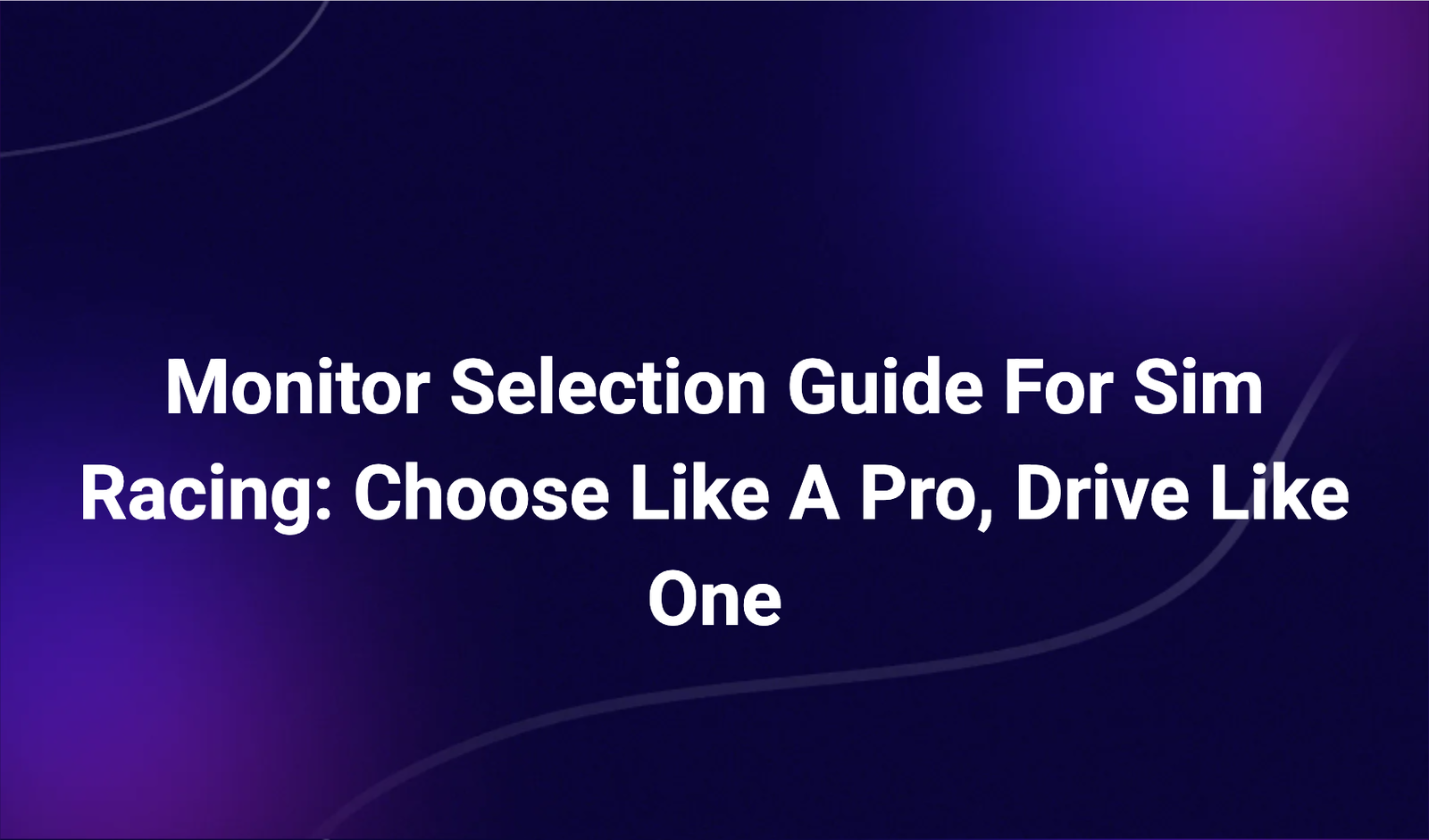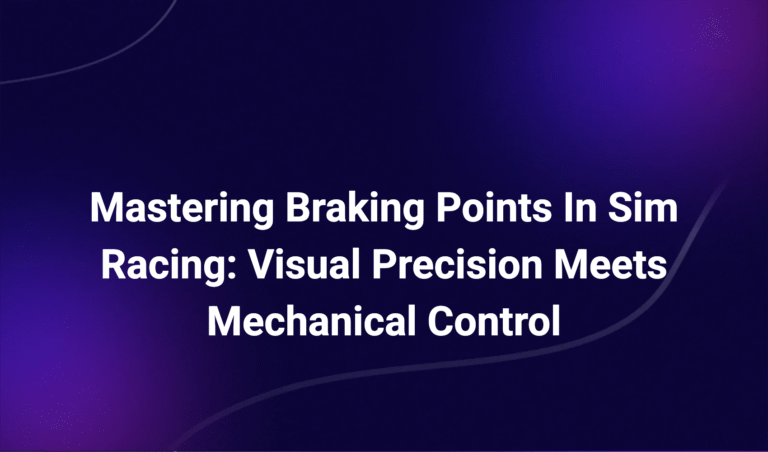Monitor Selection Guide for Sim Racing: Choose Like a Pro, Drive Like One
Introduction: Your Monitor Is Your Windshield
In sim racing, the monitor isn’t just a screen—it’s your field of reality.
What you see, how fast you process it, and how deeply you believe it all comes down to one question:
Are you using the right monitor for the job?
A poorly suited monitor will:
- Break immersion
- Distort your Field of View (FOV)
- Introduce input lag
- Impair your reaction time
- Reduce racing accuracy
In this guide, we’ll break down how to choose the ideal monitor or display setup for sim racing—from screen size and refresh rate to aspect ratio, FOV compatibility, and triple-screen or VR alternatives.
1. Understand the Visual Requirements of Sim Racing
Before jumping to brands or specs, define the core visual demands of sim racing:
- Fast motion → Needs high refresh rate & low response time
- Spatial awareness → Needs wide FOV support & proper aspect ratio
- Depth perception → Needs physical screen coverage and calibrated distance
- Consistency → Needs reliable color, low latency, and ergonomic mounting
If you want to see like a driver, your monitor must match how drivers perceive motion, space, and peripheral threats.
2. Single Monitor Setup: Entry to Intermediate
Recommended Specs:
| Feature | Ideal Value |
|---|---|
| Size | 27–32” |
| Resolution | 2560×1440 (QHD) |
| Refresh Rate | 144Hz+ |
| Response Time | 1ms–3ms |
| Panel Type | IPS or Fast VA |
| Aspect Ratio | 16:9 |
Pros:
- Affordable
- Simple setup
- Easy to mount and tune
- Supported by all games
Cons:
- Limited peripheral vision
- Reduced motion parallax
- Requires precise FOV tuning to feel realistic
Tip:
Mount the monitor so that your eyes sit centered to the screen, with a viewing distance equal to ~1x screen width. Use our FOV Calculator to match screen size + distance to a realistic visual angle.
3. Ultrawide Monitors: Enhanced Immersion in a Single Panel
Recommended Specs:
| Feature | Ideal Value |
|---|---|
| Size | 34–49” |
| Resolution | 3440×1440 (21:9) or 5120×1440 (32:9) |
| Refresh Rate | 165Hz+ |
| Curve | 1000R–1800R |
| Aspect Ratio | 21:9 or 32:9 |
Pros:
- Increased horizontal FOV
- Immersive field coverage without bezels
- Easier to mount than triples
- Great for sim racing, flight sims, and open-world games
Cons:
- Some games don’t fully support 32:9
- Requires higher GPU power
- Can distort edge perspective if FOV is not tuned
Tip:
Pair ultrawide with accurate seating position and camera settings. Avoid excessive curve unless you’re seated close (~60–70cm).
4. Triple Monitor Setup: Full Peripheral Awareness
Recommended Specs (Per Monitor):
| Feature | Ideal Value |
|---|---|
| Size | 27” |
| Resolution | 1920×1080 (minimum) |
| Refresh Rate | 144Hz+ |
| Bezel Width | Thin or bezel-less |
| Sync Technology | G-Sync or FreeSync optional |
Pros:
- 180°+ wraparound field of view
- Best spatial awareness and motion parallax
- Natural depth perception with accurate FOV scaling
- Perfect for cockpit simulators and endurance racing
Cons:
- Requires advanced mounting and GPU output
- Must angle side monitors carefully
- Some games require manual angle correction
Tip:
Use NVIDIA Surround or AMD Eyefinity for unified output. Calibrate your horizontal FOV to span across all three screens using FOVCalculator.com for perfect continuity.
5. Refresh Rate and Response Time: See It Before It Happens
Minimum Targets:
- Refresh Rate: 120Hz for casual, 144–240Hz for competitive sim racing
- Response Time: ≤3ms GtG (grey-to-grey) to avoid ghosting or blur
Higher refresh rates reduce input delay and visual stutter, especially during:
- High-speed corners
- Rapid direction changes
- Wheel-to-wheel racing
Pro Insight: Inconsistent frame pacing—even at 60 FPS—disrupts braking perception and reaction accuracy.
6. Panel Technology: IPS vs VA vs OLED
| Type | Pros | Cons |
|---|---|---|
| IPS | Accurate color, wide viewing angles, stable performance | Slightly higher input lag than TN |
| VA | High contrast, decent black levels, good for curved ultrawides | Can exhibit ghosting in dark transitions |
| OLED | Deep blacks, instant response, ultra-smooth motion | Risk of burn-in, expensive, not common in large-format triple setups |
For most sim racers, IPS is ideal for clarity, brightness, and angle stability—especially in side-mounted displays.
7. Resolution vs Performance Trade-Offs
- 1080p (FHD): Easier on GPU, acceptable on ≤27” screens
- 1440p (QHD): Sweet spot for clarity and performance on 27–32”
- 4K (UHD): Crisp visuals, heavy on GPU, often limited to 60Hz
- 5120×1440 (Super Ultrawide): Immersive and performant if GPU supports it
Pro Tip: Prioritize refresh rate and screen size over pure resolution for sim racing. 1440p @ 165Hz will outperform 4K @ 60Hz in reaction time and visual fluidity.
8. Mounting, Adjustability, and Ergonomics
Proper immersion comes from correct eye alignment and viewing distance.
| Factor | Ideal Setting |
|---|---|
| Eye Level | Centre of screen or slightly below |
| Distance | ~60–75cm for 27”, ~70–90cm for 32”+ |
| Tilt | Slight backward tilt (0°–10°) |
| Curve | Match to seating angle (1000R = aggressive, 1800R = moderate) |
Invest in a rig-mounted monitor stand for stability under braking force and motion systems.
9. VR vs Monitor: A Quick Comparison
| Factor | Triple Monitors | VR Headset |
|---|---|---|
| Peripheral Vision | Excellent | Full (360°) |
| Depth Perception | Simulated | True stereoscopic |
| Hardware Cost | Moderate–High | High |
| Visual Clarity | Excellent with tuning | Lower resolution per eye |
| Motion Sickness Risk | None | Moderate (varies by user) |
| Comfort for Endurance | High | Low–Moderate |
Choose VR for complete immersion and stereo depth; choose monitors for clarity, endurance, and setup versatility.
Final Thoughts: Don’t Just Buy a Monitor—Buy Your Experience
Your monitor shapes how you see the race, judge the road, and respond to opponents. It’s more than pixels—it’s your visual instrument panel.
When choosing a monitor:
- Prioritize proper screen-to-eyeline scale
- Match FOV to screen dimensions using our FOV Calculator
- Aim for clarity, smoothness, and wide horizontal visibility
A well-matched monitor transforms driving from a visual task into an embodied experience.
Dr. Vale’s content blends scientific precision with racer-focused clarity. Expect articles that don’t just explain the “how” but break down the “why” behind projection physics, spatial perception, and screen ergonomics in real-world terms. From triple screen angles to bezel compensation, Adrian’s work is grounded in empirical data and designed for competitive advantage.



